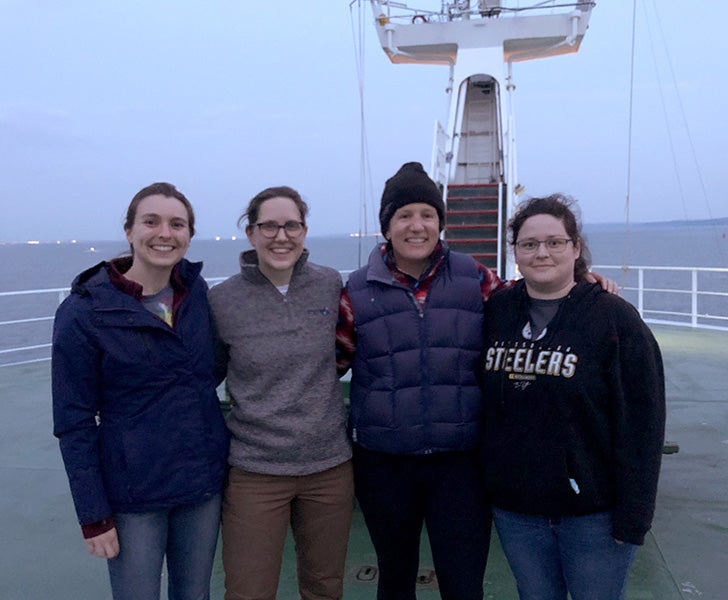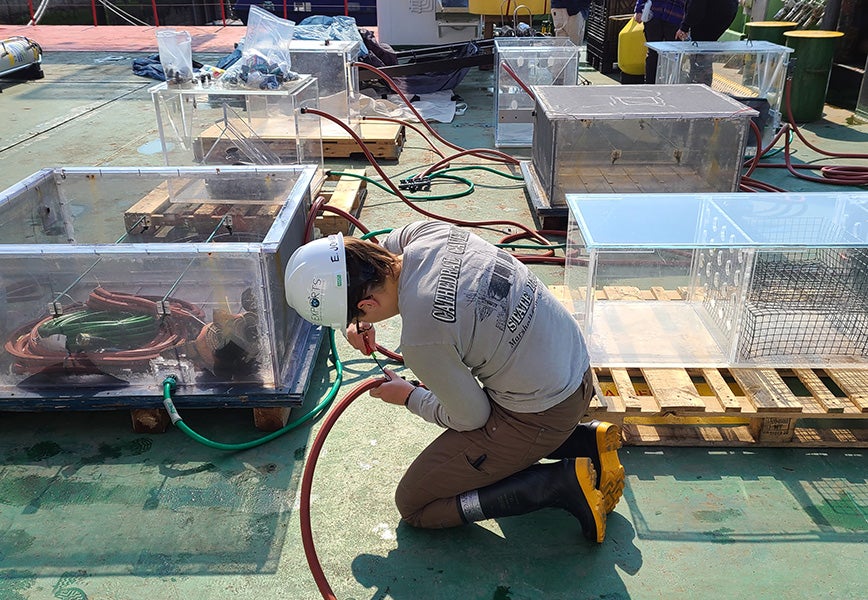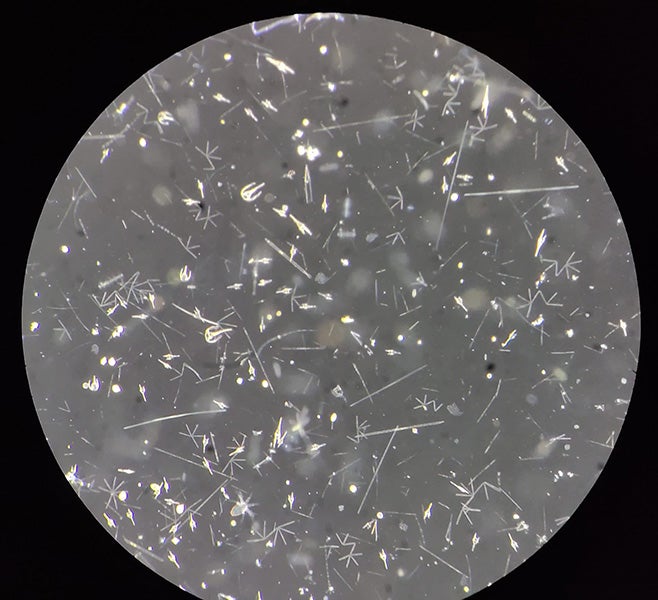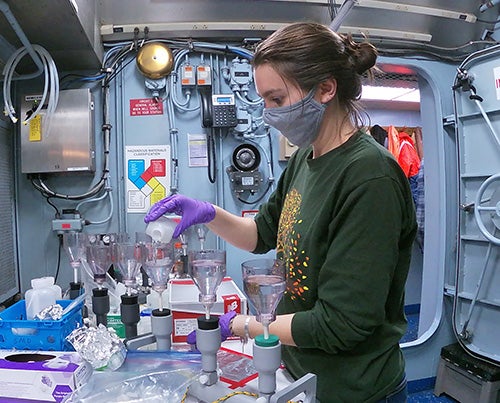By Todd Mcleish
In what some scientists call one of the largest migrations on Earth, massive numbers of small fish and zooplankton travel from the ocean depths to the surface every evening to feast on phytoplankton before returning to the depths at dawn. Based on data collected by a research team led by URI professor of oceanography Melissa Omand, some zooplankton make a similar migration during the daytime as well, in response to shifts in light from cloud cover.
The discovery results from a 2018 NASA field campaign in the North Pacific called EXPORTS (Export Processes in the Ocean from Remote Sensing), which included several GSO faculty members and graduate students working on one of two collaborating research vessels simultaneously. A second EXPORTS expedition in May 2021 in the North Atlantic served to compare the carbon export pathways in the two very different ocean basins.
“The North Pacific is a chronically iron-limited ocean,” said Bethany Jenkins, a URI professor and one of the leaders of the project. “Planktonic life needs iron for photosynthesis, but the low iron puts a productivity constraint on the ecosystem. It limits the amount of planktonic biomass that can bloom because of the low iron conditions.
“Our study site in the North Atlantic undergoes a large spring phytoplankton bloom, which is much different from our site in the Pacific,” she added. “There are many more gradients of ocean chemistry in the North Atlantic that influence the processes in the surface ocean. Because there are a lot of eddies, the mixing of deeper water nutrients to the surface supports larger phytoplankton blooms and potentially more carbon export.”
The main objective of the two EXPORTS campaigns is to examine the processes involved in the transport of carbon from the upper ocean to the dimly lit “twilight zone” several hundred meters below and compare it to what NASA can observe via satellites.
“NASA wants to know if we can see what’s going on from a satellite and make predictions,” Jenkins said. “We’re looking at it from a lot of angles, with the goal of coming up with predictive measures using mathematical algorithms to look at ocean colors by satellite that can say something about carbon delivery into the interior of the ocean.”
The research process has been complex, with upwards of 100 scientists involved in various aspects of the field work and analysis. The 2021 expedition featured three research vessels. The “process” ship remained within one water mass for the entire month to track the movement of the water and conduct daily biological experiments. The “survey” ship traveled farther afield in a grid pattern to examine the spatial variability within the entire region to study the larger ecosystem context and the ocean physics of the region. The third ship towed various instrument packages through the middle layer to assess the movement of carbon within the twilight zone.
Jenkins and her collaborators were aboard the survey ship to focus on the diatom part of the story. Diatoms fix about one quarter of all of the carbon on Earth, so they play a vital role through photosynthesis and carbon uptake.
“They’re a really important source of export in any of the ecosystems we looked at,” she said. “We were particularly interested in how the ocean chemistry was interfacing with the diatom biology and seeing if we could see the signatures in their cell physiology that tell us when they’re ready to be exported.”
“How quickly the phytoplankton are growing and how quickly the microzooplankton are eating the phytoplankton provides insight into where the carbon is going.”
Jenkins’ team, including URI postdoctoral researcher Sarah Lerch, collected daily water samples from various depths to get accurate measurements of trace elements like iron, copper, cobalt and manganese – biologically important metals that are in very low concentrations in the ocean. The water was then filtered for genetic analysis to identify the diatom community in each sample. The researchers also conducted daily incubation experiments on deck to see how the organisms react to changes in nutrient concentration.
On the process ship, GSO doctoral students Diana Fontaine and Erin Jones, along with postdoctoral researchers Heather McNair and Laura Holland, were what they called “Team Grazer.” They worked day and night to collect their own set of water samples and conducted incubation experiments to determine the productivity of the phytoplankton and to examine the rate that the microzooplankton feed or graze on the phytoplankton.
Calling themselves “glorified dish washers” for all the bottles they repeatedly had to clean, Jones said they spent most of their time filtering water.
“Our whole lab space was set up with a PVC pipe rig and carboys of water from discrete depths collected from the CTD,” she said. “We filtered water for initial chlorophyll and RNA/DNA samples, then filled incubation bottles to set up the 24-hour grazing experiment, after which we filtered for final measurements and calculated growth and grazing rates. We had big clear tanks on the back of the ship that we had shaded to represent different light levels to simulate different depths.”
“We were quantifying the rates at which the microzooplankton were eating the phytoplankton and comparing them to how quickly the phytoplankton were growing,” added Fontaine. “How quickly the phytoplankton are growing and how quickly the microzooplankton are eating the phytoplankton provides insight into where the carbon is going. The ratio of grazing to growth can tell us the amount of primary production that is consumed by microzooplankton, which can indicate how efficiently the carbon is moving up to the next level of the food web.”
Fontaine was on the overnight shift during the cruise, so she started each night by measuring the chlorophyll fluorescence from samples collected the previous day, then collected water samples at two or three o’clock each morning to start another round of incubation experiments.
“We’d sit in a dark room and put test tubes into a fluorometer, which shoots a ray of light through the test tube to give us a fluorescence value,” she explained. “That fluorescence value is used to determine the amount of chlorophyll in a sample.”
Research lab technician Roger Patrick Kelly was also aboard the process vessel. His primary job was to deploy and recover the surface-tethered sediment traps, instruments up to 500 meters long that drift freely in the ocean currents to capture sinking particles at five different depths.
“It’s a complicated process that requires the full attention of the bridge, so all ship operations have to stop to deploy them,” he said. “It takes a day to prep it for deployment, and we did three deployments and three recoveries during the cruise. In between I deployed other instruments, like Melissa Omand’s wire walker CTD and another group’s neutrally buoyant sediment traps.” Kelly did similar work on the 2018 cruise in the Pacific, which he said was different in many ways.
EXPORTS’ Global Scope
“The North Pacific, at that time of year, was a low carbon-export environment, whereas the Atlantic trip was supposed to be—and it turned out to be—when blooms were really happening. They were at the opposite end of the spectrum, as far as oceanography goes.”
The rest of the research team agreed. In the Atlantic, the ship surveyed across an eddy front during the peak of the phytoplankton bloom through to its collapse.
“In the beginning we saw lots of large diatoms at the peak of the bloom, and then we had a bunch of storms that came through and mixed things up,” said Fontaine. “We also saw aggregates forming towards the end of the bloom, which are a key part of the function of the marine food web because they sink out easily. So we saw everything from the peak bloom to the demise of the bloom.”
“One thing we’ve learned so far is that the microzooplankton community is strongly structured by light and depth, and their predatory behavior plays into that and is potentially shaped by the prey community that they’re surrounded by,” added Jones, who was analyzing the results of the 2018 EXPORTS cruise while preparing for the 2021 cruise. “I wasn’t surprised by this, but there’s not a ton known about these little grazers, so this is useful information. They’re a complicated collection of organisms.”
For Jenkins, the big picture of the EXPORTS project is just as important as all the exciting details she is learning from her specific research.
“We live in an era where our climate is changing rapidly, and the ocean is a carbon balancer in it all,” she said. “We’re flying blind unless we can understand the ocean’s role and how much of the world’s carbon emissions are being taken up by the ocean. We can’t possibly sample all of the ocean, so our best way of understanding our Earth as an ecosystem comes from satellite observations. If we can observe the carbon flow from satellites, we’ll be in a much better place.”






